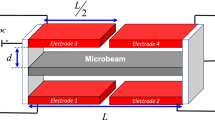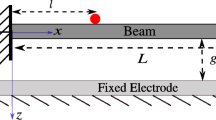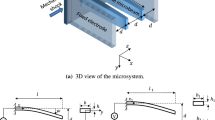Abstract
Introduction and Purpose
Nonlinear modal coupling via internal resonances and parametric excitation in MEMS resonators has been widely used to improve the functionality and performance of a wide range of potential applications. In this paper, the bandpass filter based on a 2:1 internal resonance between the second and third modes of a clamped-guided microbeam with electrostatic activation is proposed for the first time. Due to internal resonance, the amplitude–frequency response of the second mode showed a rectangle-like bandpass behaviour when the third mode is externally excited around the resonance by sweeping external excitation frequency.
Methods
In this study, numerical time integration and the method of multiple scales are used to confirm the bandpass characteristics in the amplitude–frequency response curve of the second mode of the beam.
Results
The computational results showed that the mid-plane stretching nonlinearity, excitation amplitude, and damping have a significant impact on the bandpass behaviour. We also presented the centre frequency and 3 dB bandwidth of the filter as a function of the mid-plane stretching nonlinearity parameter and a combination of excitation amplitude and damping. Moreover, we found the bandpass frequency bandwidth 261.64−1130 Hz for various axial excitation amplitude and damping combinations using a particular beam dimension and material properties from the literature. Specifically, the bandpass filter exhibited a 3 dB bandwidth of 954.97 Hz with a centre frequency of 143.09 kHz for a set of beam dimensions and material properties.
Conclusions
The internal resonance-based bandpass filter demonstrated here illustrates a novel method for building filters using a single MEMS resonator. Here, we consider electrostatically actuated clamped–guided beams, but the concept can be applied to any MEMS resonator that exhibits modal coupling based on internal resonance. In addition, it is more durable than contemporary electronic filters and is temperature-robust. The work presented here might potentially serve as a guide for investigating more MEMS resonators to create bandpass filters based on internal resonances.









Similar content being viewed by others
Data availability
The data that supports the findings of this study are available within the article.
References
Wood GS, Pu SH, Seshia AA, Zhao C, Montaseri MH, Kraft M (2016) A review on coupled mems resonators for sensing applications utilizing mode localization. Sens Actuators, A 249:93–111
Hajjaj Z, Hafiz MA, Younis MI (2017) Mode coupling and nonlinear resonances of mems arch resonators for bandpass filters. Sci Rep 7:41820
Liu H, Wang J, Xia C (2020) An oscillation based bandpass filter with a structure of two magnetically coupled orthogonal cantilevers. IEEE Trans Magn 56:1–8
Mahboob I, Flurin E, Nishiguchi K, Fujiwara A, Yamaguchi H (2011) Interconnect-free parallel logic circuits in a single mechanical resonator. Nat Commun 2:198
Chen LQ, Jiang WA (2015) Internal resonance energy harvesting. J Appl Mech 82:031004
Yamaguchi H (2017) GaAs-based micro/nano-mechanical resonators. Semicond Sci Technol 32:103003
Asadi K, Yu J, Cho H (2018) Nonlinear couplings and energy transfers in micro-and nano-mechanical resonators: intermodal coupling, internal resonance and synchronization. Philos Trans R Soc A 376:20170141
Nayfeh H, Mook DT (2008) Nonlinear oscillations. John Wiley & Sons
Hajjaj Z, Jaber N, Ilyas S, Alfosail FK, Younis MI (2020) Linear and nonlinear dynamics of micro and nanoresonators: review of recent advances. Int J Non-Linear Mech 119:103328
Lin L, Howe RT, Pisano AP (1998) Microelectromechanical filters for signal processing. J Microelectromech Syst 7:286–294
Wang K, Nguyen CT-C (1999) High-order medium frequency micromechanical electronic filters. J Microelectromech Syst 8:534–556
Bannon FD, Clark JR, Nguyen CT-C (2000) High-Q HF microelectromechanical filters. IEEE J Solid-State Circuits 35:512–526
Greywall DS, Busch PA (2002) Coupled micromechanical drumhead resonators with practical application as electromechanical bandpass filters. J Micromech Microeng 12:925
Chivukula VB, Rhoads JF (2010) Microelectromechanical bandpass filters based on cyclic coupling architectures. J Sound Vib 329:4313–4332
Zhu C, Kirby PB (2005) High-q micromachined piezoelectric mechanical filters using coupled cantilever beams. Smart SensActuators MEMS II 5836:516–526
Motiee M, Mansour RR, Khajepour A (2006) Novel mems filters for on-chip transceiver architecture, modeling and experiments. J Micromech Microeng 16:407
Hammad K, Abdel-Rahman EM, Nayfeh AH (2010) Modeling and analysis of electrostatic mems filters. Nonlinear Dyn 60:385–401
Pourkamali S, Abdolvand R, Ayazi F (2003) A 600 khz electrically-coupled mems bandpass filter. In: The Sixteenth Annual International Conference on Micro Electro Mechanical Systems, 2003. MEMS-03 Kyoto, IEEE, pp 702–705
Pourkamali S, Abdolvand R, Ho GK, Ayazi F (2004) Electrostatically coupled micromechanical beam filters. In: 17th IEEE International Conference on Micro Electro Mechanical Systems. Maastricht MEMS 2004 Technical Digest, IEEE, pp 584–587
Pourkamali S, Ayazi F (2005) Electrically coupled mems bandpass filters: part II without coupling element. Sensors Actuators A 122:317–325
Galayko D, Kaiser A, Legrand B, Buchaillot L, Combi C, Chantal C, Dominique C (2006) Coupled resonator micromechanical filters with voltage tuneable bandpass characteristic in thick-film polysilicon technology. Sensors Actuators A 126:227–240
Behzadi K, Baghelani M (2020) Bandwidth controlled weakly connected mems resonators based narrowband filter. IET Circuits Devices Syst 14:1265–1271
Kharrat E, Colinet L, Duraffourg S, Hentz P, Andreucci A et al (2010) Modal control of mechanically coupled nems arrays for tunable RF filters. IEEE Trans Ultrason Ferroelectr Freq Control 57:1285–1295
Giner J, Uranga A, Munoz-Gamarra JL, Marigo E, Barniol N (2012) A fully integrated programmable dual-band rf filter based on electrically and mechanically coupled cmosmems resonators. J Micromech Microeng 22:055020
Hajhashemi MS, Amini A, Bahreyni B (2012) A micromechanical bandpass filter with adjustable bandwidth and bidirectional control of centre frequency. Sens Actuators A 187:10–15
Ilyas S, Jaber N, Younis MI (2017) A coupled resonator for highly tunable and amplified mixer/filter. IEEE Trans Electron Dev 64:2659–2664
Ilyas S, Jaber N, Younis MI (2018) A mems coupled resonator for frequency filtering in air. Mechatronics 56:261–267
Ilyas S, Chappanda KN, Younis MI (2017) Exploiting nonlinearities of micro-machined resonators for filtering applications. Appl Phys Lett 110:253508
Syms R, Bouchaala A (2021) Mechanical synchronization of mems electrostatically driven coupled beam filters. Micromachines 12:1191
Luo T, Liu Y, Zou Y, Zhou J, Liu W, Wu G, Cai Y, Sun C (2022) Design and optimization of the dual-mode lamb wave resonator and dual-passband filter. Micromachines 13:87
Hou R, Chen J, Zhao Y, Su T, Li L, Xu K (2022) Varactor–graphene-based bandpass filter with independently tunable characteristics of frequency and amplitude. IEEE Trans Compon Packag Manuf Technol 12:1375–1385
Wu Q, Gao X, Shi Z, Li J, Li M (2022) Design and optimization of an s-band mems bandpass filter based on aggressive space mapping. Micromachines 14:67
Widaa A, Bartlett C, Hoft M (2022) Tunable coaxial bandpass filters based on inset resonators. IEEE Trans Microw Theory Techn. https://doi.org/10.1109/TMTT.2022.3222321
Jie L, Kaibo S, Shanshan G et al (2022) Miniaturized multiband bandpass filters based on a single multimode resonator loading branches. Discrete Dyn Nat Soc. https://doi.org/10.1155/2022/6260916
Luo J, Shi K, Gao S (2023) Compact multiband bandpass filters based on parallel coupled split structure multimode resonators. Electron Lett 59:e12684
Kumar P, Inamdar MM, Pawaskar DN (2020) Characterisation of the internal resonances of a clamped-clamped beam mems resonator. Microsyst Technol 26:1987–2003
Kumar P, Inamdar MM, Pawaskar DN (2020) Investigation of 3: 1 internal resonance of electrostatically actuated microbeams with flexible supports. Int Des Eng Techn Conf Comput Inf Eng Conf 83907:V001T01A006
Kumar P, Pawaskar DN, Inamdar MM (2022) Investigating internal resonances and 3: 1 modal interaction in an electrostatically actuated clamped-hinged microbeam. Meccanica 57:143–163
Narjes G, Amin N, Mohammad RA (2022) A comprehensive categorization of micro/nanomechanical resonators and their practical applications from an engineering perspective: a review. Adv Electr Mater 8:2200229
Rong W, Cao X, Dong FW, Takahito O (2021) A high-frequency narrowband filtering mechanism based on autoparametric internal resonance. In: 2021 IEEE 16th International Conference on Nano/Micro Engineered and Molecular Systems (NEMS), IEEE, pp 670–675
Chin M, Nayfeh AH (1997) Three-toone internal resonances in hinged-clamped beams. Nonlinear Dyn 12:129–154
Kumar P, Muralidharan B, Pawaskar DN, Inamdar MM (2022) Investigation of phonon lasing like auto-parametric instability between 1- d flexural modes of electrostatically actuated microbeams. Int J Mech Sci 220:107135
Younis MI (2011) MEMS linear and nonlinear statics and dynamics, volume 20. Springer Science & Business Media
Alcheikh N, Ramini A, Hafiz MAA, Younis MI (2017) Tunable clamped– guided arch resonators using electrostatically induced axial loads. Micromachines 8:14
Alcheikh N, Tella SA, Younis MI (2018) Adjustable static and dynamic actuation of clamped-guided beams using electrothermal axial loads. Sens Actuators, A 273:19–29
Joshi S, Hung S, Vengallatore S (2014) Design strategies for controlling damping in micromechanical and nanomechanical resonators. EPJ Tech Instrum 1:1–14
Author information
Authors and Affiliations
Corresponding author
Additional information
Publisher's Note
Springer Nature remains neutral with regard to jurisdictional claims in published maps and institutional affiliations.
Appendix
Appendix
Derivation of Governing Equation
We consider the dynamic response of a clamped-guided microbeam to electrostatic force. The guided end of the beam is modelled as a linear axial spring. We assume that the cross sections remain plane during transverse bending. By utilising moment balance and the relationship between shear force and moment, we find the coupled two partial differential equations corresponding transverse \(w\left(x,t\right)\) and axial \(u\left(x,t\right)\) deflections [43]
The axial natural frequency is much higher than the transversal natural frequency. Hence, the inertia term \(\ddot{u}\) in Eq. 14 can be ignored and the axial deformation becomes
To obtain axial deflection, we integrate Eq. 16 twice with respect to \(x\)
where \({C}_{1}\left(t\right)\) and \({C}_{2}\left(t\right)\) are constants of integration. To obtain these constants, we use clamped and guided (restrained by a linear spring) boundary conditions for the axial motion. Hence, boundary conditions can be expressed as
where \(L\) is undeformed beam length and \({K}_{a}\) stiffness of axial spring.
Substituting Eq. 18 into Eq. 17 gives
Substituting Eq. 19 into Eq. 17 and then the outcome into Eq. 15 yield
Equation 20 is the nonlinear governing equation of motion that is typically used for beam vibration with mid-plane stretching. Here, \(F\) is electrostatic force per unit length in a parallel-plate capacitor [43]
where \(g\) is the electrode gap between the beam and the substrate, \({V}_{dc}\) is the DC voltage, and \({V}_{ac}\) and \(\Omega\) the AC harmonic voltage amplitude and frequency, respectively.
Rights and permissions
Springer Nature or its licensor (e.g. a society or other partner) holds exclusive rights to this article under a publishing agreement with the author(s) or other rightsholder(s); author self-archiving of the accepted manuscript version of this article is solely governed by the terms of such publishing agreement and applicable law.
About this article
Cite this article
Kumar, P., Pawaskar, D.N. & Inamdar, M.M. Investigation of a Bandpass Filter Based on Nonlinear Modal Coupling via 2:1 Internal Resonance of Electrostatically Actuated Clamped-Guided Microbeams. J. Vib. Eng. Technol. 12, 3783–3796 (2024). https://doi.org/10.1007/s42417-023-01084-3
Received:
Revised:
Accepted:
Published:
Issue Date:
DOI: https://doi.org/10.1007/s42417-023-01084-3




